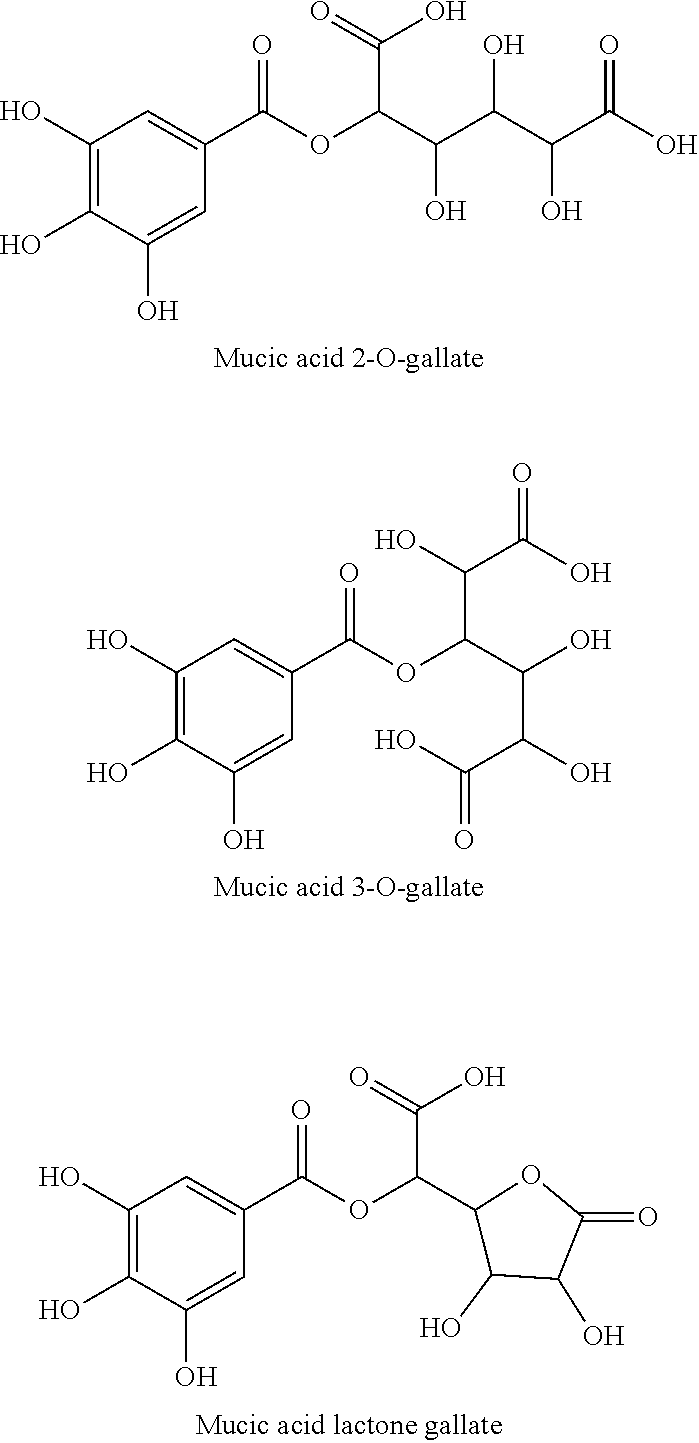Novel compositions for taste masking
a composition and taste technology, applied in the field of new compositions for taste masking, can solve the problem of limiting their application in consumables
- Summary
- Abstract
- Description
- Claims
- Application Information
AI Technical Summary
Benefits of technology
Problems solved by technology
Method used
Image
Examples
example ii
the Lingering Aftertaste of Steviol Glycosides by Mucic Acid 2-O-Gallate and Mucic Acid Lactone Gallate
[0034]A base solution of αG SWEET (Alpha Glucosyl Stevioside, Toyo Sugar Refining Co., Ltd., Japan) was prepared in water at a concentration of 0.08%. Test sample solutions of mucic acid 2-O-gallate and mucic acid lactone gallate (prepared as above in Example I) in the base solution at the levels shown in the table below were each prepared.
[0035]Sample pairs (a base solution and a test sample solution) were presented in a blind and pseudorandom order to a sensory panel. The lingering aftertaste-masking effect was recorded based on the percentages of the panelists who ranked the sample having less bitter and metallic aftertaste and lingering sweetness. Binomial statistical analysis was used to compare the masking effect of lingering aftertaste for each sample pair. Significance was at 95% Confidence Interval (p<0.05). The test results are as follows:
Sample SolutionResultp ValueMucic...
example iii
the Lingering Aftertaste of Steviol Glycosides by the Mucic Acid 2-O-Gallate and Mucic Acid Lactone Gallate Mixture
[0036]A solution of αG SWEET was prepared in water at a concentration of 0.14%. The Emblica officinalis fruit extract (prepared as above in Example I) containing the mucic acid 2-O-gallate (11.84%) and mucic acid lactone gallate (6.35%) mixture, individual fractions containing each of mucic acid 2-O-gallate, mucic acid lactone gallate, galloyl glucose (prepared in Example I) and mucic acid 3-O-gallate (Quality Phytochemicals, LLC, New Jersey, U.S.) were added to the αG SWEET solution, respectively, to achieve a series of concentrations ranging from about 50-80 ppm for the Emblica officinalis fruit extract; about 5-20 ppm for mucic acid 2-O-gallate; about 5-20 ppm for mucic acid 3-O-gallate; about 2-10 ppm for mucic acid lactone gallate; and about 10-20 ppm for galloyl glucose. Water was used in a control group.
[0037]Samples were presented in a blind and pseudorandom ord...
example iv
the Lingering Aftertaste of Different Non-Sugar Sweeteners by Mucic Acid 2-O-Gallate and Mucic Acid Lactone Gallate Mixture
[0040]Different base solutions of non-sugar sweeteners including (i) acesulfame potassium (0.02%); (ii) aspartame (0.02%); (iii) sucralose (0.01%); and (iv) αG SWEET (0.04%) were prepared in water. Test sample solutions of the Emblica officinalis fruit extract (prepared as above in Example I) containing the mucic acid 2-O-gallate (11.84%) and mucic acid lactone gallate (6.35%) mixture were prepared in each base solution at a concentration of 70 ppm.
[0041]Sample pairs (a base solution and a test sample solution) were presented in a blind and pseudorandom order to a sensory panel. The test results are as follows:
Non-SugarSweetenersResultAcesulfameLess overall off-taste but not too significant, decreasedPotassiumsweetness up front, slightly decreased lingering, slight(0.02%)reduction of mineral and waxy off-tasteAspartameSlightly decreased off-taste up front, very ...
PUM
 Login to View More
Login to View More Abstract
Description
Claims
Application Information
 Login to View More
Login to View More - R&D
- Intellectual Property
- Life Sciences
- Materials
- Tech Scout
- Unparalleled Data Quality
- Higher Quality Content
- 60% Fewer Hallucinations
Browse by: Latest US Patents, China's latest patents, Technical Efficacy Thesaurus, Application Domain, Technology Topic, Popular Technical Reports.
© 2025 PatSnap. All rights reserved.Legal|Privacy policy|Modern Slavery Act Transparency Statement|Sitemap|About US| Contact US: help@patsnap.com

